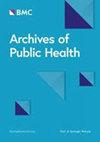Multilevel factors associated with HIV-related stigma among women living with HIV in Guangdong Province, China: a social-ecological model-informed study
IF 3.2
3区 医学
Q2 PUBLIC, ENVIRONMENTAL & OCCUPATIONAL HEALTH
引用次数: 0
Abstract
HIV-related stigma continues to hinder optimal HIV care, and its determinants should be understood at multiple levels. Based on the social-ecological model, this study aimed to explore factors associated with HIV-related stigma among women living with HIV in Guangdong Province, China. A cross-sectional study was conducted from July to August 2022 to recruit newly reported women living with HIV with a history of pregnancy or current pregnancy in 2021 in 21 cities in Guangdong Province. HIV-related stigma was assessed using an abbreviated Chinese version of Berger's HIV Stigma Scale. Univariate and multivariable hierarchical regression analyses based on the social-ecological model were conducted to explore factors associated with HIV-related stigma and its four dimensions (personalized stigma, disclosure concerns, negative self-image and concerns about public attitudes) at the community/hospital, interpersonal, and individual levels. A moderate level of HIV-related stigma was found among the 360 participants included, with a mean score of 45.26. Multivariable hierarchical regression analysis showed that at the community/hospital-level, individuals were more likely to experience high levels of HIV-related stigma if they had experienced the discriminatory behaviors from health care workers (aOR = 2.34, 95%CI: 1.48–3.70) and if they rated serostatus disclosure services as less helpful (aOR = 0.69, 95%CI: 0.48–0.98). At the interpersonal-level, individuals with an HIV-positive partner (aOR = 1.71, 95%CI: 1.01–2.90) were more likely to experience high levels of HIV-related stigma than those with an HIV-negative or unknown partner. Individuals with high resilience (aOR = 0.22, 95%CI: 0.13–0.35) had lower levels of HIV-related stigma at the individual-level. In addition, ever experiencing discriminatory behaviors from health care workers, thinking serostatus disclosure services helpful, having ever seen publicity about personal interest protection services and complaint channels for people living with HIV(PLHIV), knowing about care and support services for PLHIV from social organizations at the community/hospital-level, partner notification and support at the interpersonal-level, and violations of personal interests, resilience at the individual-level were also associated with different dimensions of HIV-related stigma. HIV-related stigma was moderate among women living with HIV. The social-ecological model can facilitate a better understanding of factors associated with HIV-related stigma. Multilevel intervention strategies need to be tailored to reduce HIV-related stigma.与中国广东省女性艾滋病病毒感染者艾滋病相关污名化相关的多层次因素:一项基于社会生态模型的研究
与艾滋病相关的污名化仍然阻碍着最佳的艾滋病关怀,应从多个层面了解其决定因素。基于社会生态模型,本研究旨在探讨中国广东省女性艾滋病病毒感染者中与艾滋病相关的污名化的相关因素。本研究于 2022 年 7 月至 8 月在广东省 21 个地市开展了一项横断面研究,招募了 2021 年新报告的有妊娠史或正在妊娠的女性艾滋病病毒感染者。研究采用伯杰艾滋病耻辱感量表(Berger's HIV Stigma Scale)的简体中文版对艾滋病相关耻辱感进行评估。研究人员基于社会生态模型进行了单变量和多变量分层回归分析,从社区/医院、人际和个人三个层面探讨了与艾滋病相关的污名化及其四个维度(个人化污名化、对信息披露的担忧、负面自我形象和对公众态度的担忧)相关的因素。研究发现,360 名参与者的艾滋病相关耻辱感处于中等水平,平均得分为 45.26 分。多变量分层回归分析表明,在社区/医院层面,如果个人曾遭受过医护人员的歧视行为(aOR = 2.34,95%CI:1.48-3.70),如果他们认为血清状况公开服务的帮助较小(aOR = 0.69,95%CI:0.48-0.98),那么他们更有可能遭受高度的艾滋病相关污名化。在人际关系层面,与艾滋病毒阴性或未知伴侣相比,艾滋病毒阳性伴侣(aOR = 1.71,95%CI:1.01-2.90)更有可能遭受高度的艾滋病毒相关污名化。在个人层面上,复原力高(aOR = 0.22,95%CI:0.13-0.35)的人受到的艾滋病相关污名化程度较低。此外,曾经遭遇过医护人员的歧视行为、认为血清状态公开服务有帮助、曾经看到过有关艾滋病病毒感染者(PLHIV)个人利益保护服务和投诉渠道的宣传、了解社区/医院层面的社会组织为艾滋病病毒感染者提供的关怀和支持服务、人际层面的伴侣通知和支持、个人利益受到侵犯、个人层面的复原力也与艾滋病相关污名的不同维度相关。在感染艾滋病毒的妇女中,与艾滋病毒相关的污名化程度适中。社会生态模型有助于更好地理解与艾滋病毒相关的污名化相关的因素。需要制定多层次的干预战略,以减少与艾滋病毒相关的污名化。
本文章由计算机程序翻译,如有差异,请以英文原文为准。
求助全文
约1分钟内获得全文
求助全文
来源期刊

Archives of Public Health
Medicine-Public Health, Environmental and Occupational Health
CiteScore
4.80
自引率
3.00%
发文量
244
审稿时长
16 weeks
期刊介绍:
rchives of Public Health is a broad scope public health journal, dedicated to publishing all sound science in the field of public health. The journal aims to better the understanding of the health of populations. The journal contributes to public health knowledge, enhances the interaction between research, policy and practice and stimulates public health monitoring and indicator development. The journal considers submissions on health outcomes and their determinants, with clear statements about the public health and policy implications. Archives of Public Health welcomes methodological papers (e.g., on study design and bias), papers on health services research, health economics, community interventions, and epidemiological studies dealing with international comparisons, the determinants of inequality in health, and the environmental, behavioural, social, demographic and occupational correlates of health and diseases.
 求助内容:
求助内容: 应助结果提醒方式:
应助结果提醒方式:


